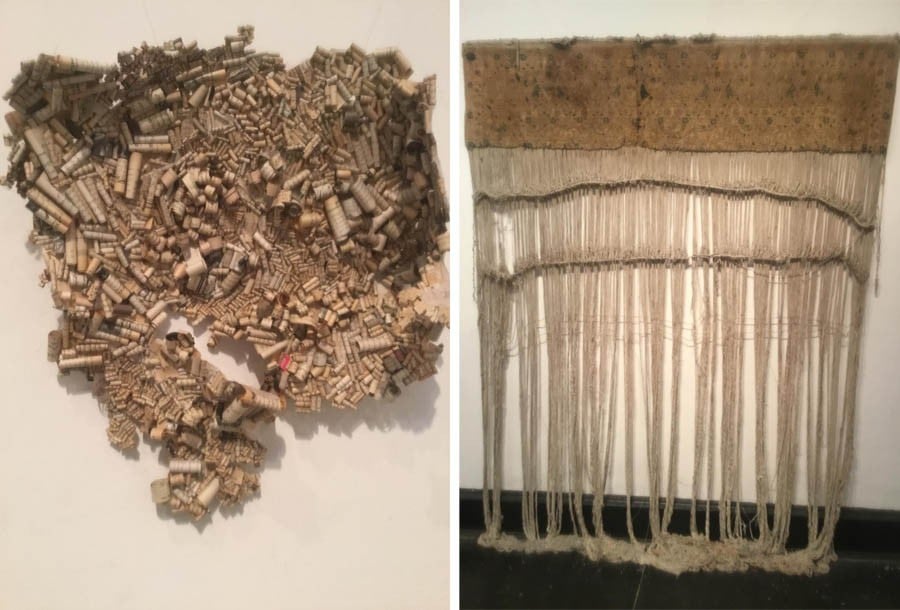
The NCA Masters thesis show was testament to the rich traditions that the arts institute is renowned for

The National College of Arts (NCA)’s Masters thesis show kicked off last week in Lahore. It was a sizable display, featuring over a dozen students. Other comparable institutions like the Punjab University put up a display with just three students, by way of comparison.
Not only did the MA Honours students put on an impressive show but there were the rich traditions that NCA is renowned for. There was a thesis display that used punching tools on Wasli, bringing out patterns on the canvas. There were other miniatures measuring the minute but noticeable changes in grass and growth; like a miniature garden growing in a lawn. There were, of course, many installations showing projections and mixed media images. There were acrylic sheets, one showing a 12-inch sphere of nickel coated brass. It was perfectly contoured image distortion, called Parallax for the effect it produced.
Unaiza Ismail was clearly the star of the show, as she mixed humour, honesty and a harrowing depiction of a pumpkin being taken to the grinder. She depicted silhouettes of undergarments and other discarded items strewn across a clothesline. What she had attempted to explore was the unspoken and burgeoning sexuality of a young girl. It was a brilliant montage of bras, pants, and all the other paraphernalia taken off while putting on skin. It was all shadows and yet so raw.
Even rawer was the chicken being stuffed and put on the shredder. Gory is not the word one associates with a pumpkin. An extremely visceral depiction of something that is held in a high religious esteem and diced into gory bits was strangely satisfying.
Ismail elevated her art form to satire next, with an archival print called Meaty Balls. It was made on German Hahnemuhle Paper. The wordplay included a Pak Milk Cream. "Squeezed For Health," it said, processed and yet "healthy." Chicken Dikkha was playing on the word that looked like meat but it was just frozen, packaged consumerism. Another was called Rational Rasala Pix, something that looked deliciously like meat more than it tasted like meat. The packaged and processed milk and meat, which was dressed in the gaudy apparel of the undergarments of food, tied the entire thing very nicely together.
The second piece on display which caught my eye was the first -- also torn to bits, but unlike pulp it was woven. It was by Marjan Baniasadi and involved old carpets well worn by use. One lovely old thing was adorned with tassels, most were shorn of their weave. Baniasadi took us through the process of being cut up, which is evident in her artwork as shredded carpets feature as prominently as rugs threaded bare. ‘Weave In Time’ was how one of the works was titled, gently reminding us of the imprint human lives leave behind, even when viewed through the lens of textile.
Zakir Baloch did something interesting with his work: he wrote headlines and blurbs and in news print. It was not only a way of arranging a montage of local print media, they came together as a collection of fine print which was also saying things in the even finer print. He had folded them into cylindrical shapes, it was collecting our history. We leave behind a wealth of symbols and signs as they individually make a collective panorama of print and publishing.
Fozia Bano, following on from the linguistic symbolism, made inscriptions in the Sindhi script. The theme of remembrance in local languages was strong in the thesis show, or rather forgotten remembrances. We were furnished with a half completed script where she purposefully left words incomplete because the language is not well understood, or as common anymore. It is also left unstudied by a multitude which leaves us wanting more. These were the remnants of a local language left unattended while we were left unfulfilled.
Mahrukh Bajwa started with a Sylvia Plath quote, saying that she always wanted to observe events going on around her, often in a humorous light where she could mock others as she mocked herself. Bajwa painted the denizens of her universe in a fittingly confused light. People with blanked out faces were portrayed in a din of noise and sin. One person had something resembling a trumpet for a face attracting attention to themselves, and attracting the requisite attention to Plath’s introspective world.
Aakif Suri made an artistic reference to the ‘Tumandar’ -- tribal Baloch chiefs trying to capture the deformities left by a colonial intrusion into the lifeblood of the land. He showed furniture like a chair with nails where the comfort ought to be. More furniture is stripped bare resembling shapes hanging on to the silhouettes, which were vaguely like animals. There was also a gigantic seat with a swollen belly, like a pregnant idea, a horrifying yet containing pregnant idea, full of possibilities.
In Ahmed Shahzad’s work, there was a sandbox where you could write and doodle. An interactive piece, basically. It’s curious that both the times I saw it I saw hand prints and footprints in the sand -- ephemeral, vanishing, impermanent. Shahzad was looking for spontaneous and creative remarks left by curious people, but the remarks ended up saying more about us than the writing in the sand.
Namrah Fatima made traditional paintings on canvas. These were a collection of dishes, glasses, shoes, boxes, basins, and clutter under the sink. The canvas was also filled to the brim with little items that clutter closets and is laid out in shelves. It was a very comfortable and cosy imagery.